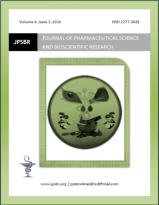





Requirements of Common Technical Document Preparation -A Technical Drive
Kinjalkumar V. Patel, Darshil B. Shah





A Review on Regulatory Bodies for Oncology Drug Approval Process – A Global Perspective
Ketul Vora, Dilip Maheshwari, Nirav Chokshi




Volume 4, Issue 3
Pages no. 184-227

Formulation and Evaluation of Sustained Release Tablets Containing Atomoxetine Hydrochloride
Jalpa Patel, Nihar Shah





Formulation and Evaluation of Olmesartan Medoxomil Mouth Dissolving Film
Vidhi Desai, Nihar Shah





Regulation of Drug and Medical Device in USA
Shraddha Makwana, Krupa Thula, Dr. Dilip Maheshwari





Formulation and Optimization of Acyclovir Floating Tablet
Aatish Thakkar, Nishith Patel, Dipen Patel Soni Tomar






Development and Validation of Stability Indicating RP-HPLC Method for Estimation of Bezafibrate in Tablet
Dosage Form
Hitesh G. Prajapati*, Dipen k. Shah, Ms. Bhumika Sakhreliya






© JPSBR Publications 2011-2024
Powered by Opus
ABSTRACT
The CTD is a harmonized registration dossier which can be submitted into Europe, USA, Japan, Canada and
Australia. CTD is used for Drug products for human use, Biotechnological products, Herbal products and drug filing.
CTD is mainly consists of five modules. Central Drugs Standard Control Organization (CDSCO), India has also
decided to adopt CTD format for technical requirements for registration of pharmaceutical products for human
use. Implementation of CTD is expected to significantly reduce time and resources needed by industry to compile
applications for global registration.
KEYWORDS:
CTD, CDSCO, ICH, DCGI, NDA
ABSTRACT:
This article explains the role of external advisory bodies in oncology drug development and regulation from a global
perspective. It contains the role of external advisors of United States Food & Drug Administration, European Medicines Agency,
Health Canada, the Japanese Pharmaceuticals & Medical Devices Agency & the state food & drug administration china in
oncology drug development and regulation in each of jurisdiction was explained and mentioned. It gives the clear cut idea about
the role of the advisory committee of the countries like USA, Europe, Canada, Japan & China and their regulation system for
approval of oncology drug products in global pharmaceutical market.
KEYWORDS: Oncology, Regulatory Bodies, Advisory Committee, Drug Regulation
ABSTRACT
The purpose of this research work was to establish sustained release tablets of Atomoxetine hydrochloride. The tablets were
prepared by direct compression technique using HPMC-K4M, HPMC-K100M, Eudragit RSPO, Ethyl Cellulose as Sustained release
polymer. These SR tablets were evaluated by different parameters such as weight variation, friability, assay, hardness, thickness,
swelling index, in-vitro drug release study. The F9 formulation (containing HPMC K100M : EC)are optimized on the basis of in-
vitro drug release studies.
KEYWORDS: Sustained release tablets, Atomoxetine hydrochloride
ABSTRACT:
The oral route is the most preferred route, though preoral administration of drug has disadvantage like hepatic first pass
metabolism and enzymatic degradation within the GI tract however trans mucosal routes of drug delivery ( i.e. Mucosal lining of
nasal, rectal, vaginal, ocular, & oral cavities) offer distinct advantage over preoral administration because mucosa are
permeable and well supplied with vascular and lymphatic drainage. Their other advantages include bypass of first pass effects
and avoidance of pre-systematic elimination within GI tract. The present investigation highlights the formulation and evaluation
of mouth dissolving films of Olmesartan Medoxomil, prepared by solvent casting technique. Film made up of different polymers
but combination of HPMC E15 and PVA was optimized as final formulation.
KEYWORDS: Olmesartan Medoxomil,β-Cyclodextrins, HPMC E15, PVA, Mouth Dissolving films, Solvent casting technique.
ABSTRACT:
Developing a new drug required great amount of research work in chemistry, manufacturing, control, preclinical
science and clinical trials. Every country has its own regulatory authority which is responsible of evaluating
whether the research data support the safety, effectiveness and quality of new drug product and to enforce the
guidelines which regulating the marketing of new drug. Similarly, Medical device regulation plays a significant role
in the design, development, and commercialization of new medical technologies. A comprehensive understanding
of the various regulatory requirements and their practical implementation is thus an essential cornerstone of
successful medical device innovation. Medical devices which are used to treat different diseases and which can be
used by physician in different surgeries must go through the regulatory process to check its safety and
effectiveness before going through clinical trial and marketing. This article focuses on history, mission, statutory
requirements, administration and related issues with respect to drugs and medical devices in United State of
America (USA).
KEYWORDS:
Regulatory process, Regulatory authority, Clinical trial, Medical Device, USA


ABSTRACT:
The
present
research
work
aims
to
formulation
of
floating
and
in-vitro
evaluation
of
acyclovir
floating
tablet
using
direct
compression
method.
The
potential
ingredients
used
as
floating,
swallable
polymer
are
HPMC
K100
LV
and
Psyllium
Husk
with
gas
generating
agent
Sodium
Bicarbonate.
Psyllium
husk
was
specially
treated
to
improve
its
direct
compression
property.
Simplex
lattice
design
was
used
to
carry
out
optimization.
Seven
batches
were
prepared
using
three
independent
variable
F
lag
and
Cumulative
%
release
5
h&
10h
as
independent
variables.
Regression
analysis
showed
significant
coefficients
at
P
<
0.05.
The
final
optimized
batch
was
generated
using
polynomial
equation
and
2D
Plots.
Release
kinetics
of
optimized
batch
revealed
that
drug
release
mechanism
follows
non-
fickain,
anomalous
diffusion
(n=0.5-0.85)
and
tablets
were
testes
for
3
month
accelerated
stability
study.
Cumulative
%
release
before
and
after
Stability
batches
were
tested
by
t
test
which
shows
significant
result
tcal<ttab.
Thus
gastroretentive
floating
drug
delivery
tablets
of
acyclovir using HPMC, Psyllium husk and Sodium bicarbonate shows promising drug delivery system.
KEYWORDS:
HPMC K100LV, Psyllium Husk, Simplex Lattice design, acyclovir, floating, gastro retentive
ABSTRACT:
A
stability-indicating
reversed-phase
high
performance
liquid
chromatography
(RP-HPLC)
method
was
developed
for
the
determination
of
Bezafibrate,
a
drug
used
in
the
treatment
of
Hyperlipidemia.
The
desired
chromatographic
separation
was
achieved
on
a
ZORBAX
XDB
C-18
(150*4.6)5µ
column,
using
isocratic
elution
at
a
228
nm
detector
wavelength.
The
optimized
mobile
phase
consisted
of
a
ACN:
WATER
(60:40v/v,
pH
2.8
adjusted
with
10%
o
-phosphoric
acid)
as
solvent.
The
flow
rate
was
1.5
mL/min
and
the
retention
time
of
Bezafibrate
was
5.55
min.
The
linearity
for
Bezafibrate
was
in
the
range
of
5-40
μg/mL.
Recovery
for
Bezafibrate
was
calculated
&
stability-indicating
capability
was
established
by
forced
degradation
experiments
.The
developed
RP-HPLC
method
was
validated
according
to
the
International
Conference
on
Harmonization
(ICH)
guidelines.
This
validated
method
was
applied
for
the
estimation
of
Bezafibrate in commercially available tablets.
KEYWORDS:
Bezafibrate, method validation, forced degradation, RP-HPLC, Hyperlipidemia






































































































